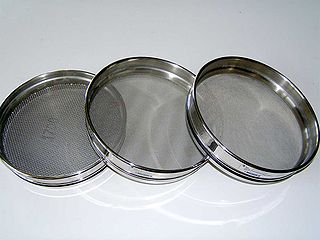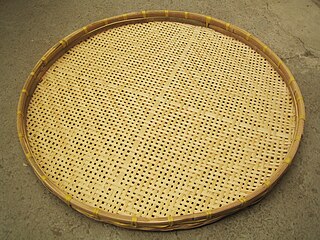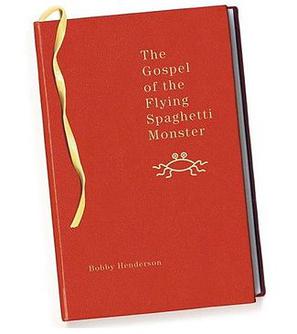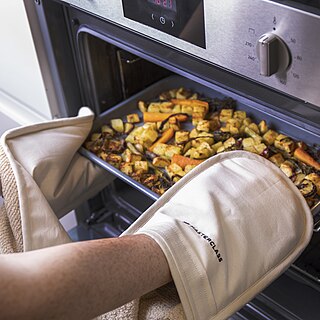
Minestrone is a thick soup of Italian origin made with meats, vegetables, and pasta. Ingredients include beans, onions, celery, carrots, leaf vegetables, stock, parmesan cheese and tomatoes.

Spaghetti is a long, thin, solid, cylindrical pasta. It is a staple food of traditional Italian cuisine. Like other pasta, spaghetti is made of milled wheat, water, and sometimes enriched with vitamins and minerals. Italian spaghetti is typically made from durum-wheat semolina. Usually the pasta is white because refined flour is used, but whole wheat flour may be added. Spaghettoni is a thicker form of spaghetti, while spaghettini is a thinner form. Capellini is a very thin spaghetti, sometimes known colloquially as "angel hair pasta", while Vermicelli refers to intermediate widths, varying between the United States and Italy.

Asia Carrera Lemmon is an American former pornographic actress.

Lasagna is a type of pasta, possibly one of the oldest types, made of very wide, flat sheets. Either term can also refer to an Italian dish made of stacked layers of lasagna alternating with fillings such as ragù, béchamel sauce, vegetables, cheeses, and seasonings and spices. The dish may be topped with grated cheese, which becomes melted during baking. Typically cooked pasta is assembled with the other ingredients and then baked in an oven. The resulting baked pasta is cut into single-serving square or rectangular portions.

Vermicelli is a traditional type of pasta round in section similar to spaghetti. In English-speaking regions, it is usually thinner than spaghetti, while in Italy, it is thicker.

A sieve, fine mesh strainer, or sift, is a device for separating wanted elements from unwanted material or for controlling the particle size distribution of a sample, using a screen such as a woven mesh or net or perforated sheet material. The word sift derives from sieve.

Carbonara is a pasta dish made with eggs, hard cheese, fatty cured pork, and black pepper. The dish took its modern form and name in the middle of the 20th century.

A parody religion or mock religion is a belief system that challenges the spiritual convictions of others, often through humor, satire, or burlesque. Often constructed to achieve a specific purpose related to another belief system, a parody religion can be a parody of several religions, sects, gurus, cults, or new religious movements at the same time, or even a parody of no particular religion – instead parodying the concept of religious belief itself. Some parody religions emphasise having fun; the new faith may serve as a convenient excuse for pleasant social interaction among the like-minded.

A zaru is generally a flat or shallow basket made from bamboo used in the preparation and presentation of Japanese cuisine. It also has variations made of plastic or metal similar to a strainer, sieve or colander.

Kitchenware are the tools, utensils, appliances, dishes, and cookware used in food preparation, or the serving of food. Kitchenware can also be used in order to hold or store food before or after preparation.

Linguine is a type of Italian pasta similar to fettuccine and trenette, but elliptical in section rather than flat. It is about 4 millimetres in width, which is wider than spaghetti, but not as wide as fettuccine. The name linguine means 'little tongues' in Italian, where it is a plural of the feminine linguina. A thinner version of linguine is called linguettine. Linguine was traditionally served with sauces such as pesto, but others such as tomato or fish based sauces are popular as well. Linguine is typically available in both white flour and whole-wheat versions, but was originally made with durum wheat. Linguine originated in Italy and is based on more traditional pastas. It is a type of pasta that finds its origin in Genoa. In the United States, National Linguine Day occurs on September 15 every year.

A chinois is a conical sieve with an extremely fine mesh. It is used to strain custards, purees, soups, and sauces, producing a very smooth texture. It can also be used to dust food with a fine layer of powdered ingredient.

The Flying Spaghetti Monster (FSM) is the deity of the Church of the Flying Spaghetti Monster, or Pastafarianism, a parodic new religious movement that promotes a light-hearted view of religion. It originated in opposition to the teaching of intelligent design in public schools in the United States. According to adherents, Pastafarianism is a "real, legitimate religion, as much as any other". It has received some limited recognition as such.

A food mill is a food preparation utensil for mashing and sieving soft foods invented in Brussels in 1928 by Victor Simon. Typically, a food mill consists of three parts: a bowl, a bottom plate with holes like those in a colander, and a crank fitted with a bent metal blade that crushes the food and forces it through the holes in the plate. The bottom plate may be a permanent part of the device, or interchangeable plates with different hole sizes may be supplied. Three corrugated feet on the base, or two ears on the rim plus the handle, fit on the rim of a cooking pot and hold the mill in position over it.

The Gospel of the Flying Spaghetti Monster is a satirical book written by Bobby Henderson that embodies the main beliefs of the parody religion of the Church of the Flying Spaghetti Monster or Pastafarianism. The Flying Spaghetti Monster (FSM) was created by Bobby Henderson in an open letter to the Kansas State Board of Education in which he parodied the concept of intelligent design. After Henderson posted the letter on his website, it became an internet phenomenon and was featured in many large newspapers, which caught the attention of book publishers. Released in March 2006 by Villard Books, The Gospel elaborates on Pastafarian beliefs and practices established in the open letter.

An oven glove, also commonly known as an oven mitt, is a thermal insulated glove or mitten usually worn in the kitchen to easily protect the wearer's hand from hot objects such as ovens, stoves, cookware, etc. They are functionally similar to pot-holders, but designed to be worn over one's entire hand.
Bobby Henderson is an American physics graduate, known for being the founder of Pastafarianism.

A spider is a type of skimmer prevalent in East Asian cuisine in the form of a wide shallow wire-mesh basket with a long handle, used for removing hot food from a liquid or skimming foam off when making broths. The name is derived from the wire pattern, which looks like a spider's web. It has been widely adopted in Western cuisine by cooks who favour the open mesh over slotted spoons for faster and safer drainage.

Spaghetti aglio e olio is a traditional Italian pasta dish from Naples. It is a typical dish of Neapolitan cuisine and is widely popular. Its popularity can be attributed to it being simple to prepare and the fact that it makes use of inexpensive, readily available ingredients that have long shelf lives in a pantry.



















